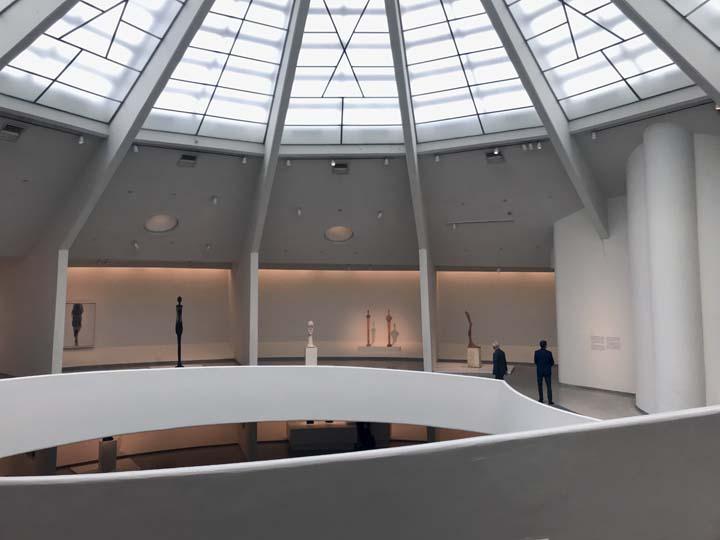Giacometti
The expansive exhibition of works by Alberto Giacometti (1901-1966) currently on view at the Guggenheim examines the artist's career in its entirety. Spaciously installed throughout the museum’s rotunda, the show features nearly 200 sculptures, paintings and drawings, along with vintage photographs, mural-size photographs of the artist’s Paris studio, and ephemera. The first major museum presentation in over 15 years, it offers visitors a fresh opportunity to understand the work and process of this protean artist.

Anxiety and alienation were the existential problem of 20th-century Europe, informing the shift from realism to Surrealism, and from representation to abstraction. But Giacometti saw himself somewhat apart from current trends: a realist attempting the “impossible” task of representing the appearance of things as he saw them. Impossible, as for him the foundational quest was to capture the ungraspable essence of human interaction. Ed. note: For the purpose of this posting, I look at Giacometti’s post-Surrealist, post-war output.
At the close of World War II, in 1945, Giacometti returned from his self-imposed exile in Geneva to his Paris studio. While in Switzerland, he was forced to miniaturize his sculptures due to the confines of his small apartment. He saved these tiny pieces, a number of which are on view, in matchboxes that he carried back to Paris in his pockets.
After four years of displacement, the return to a more normal existence was not an easy transition for him. In pursuit of “rendering” his vision, Giacometti returned to drawing and painting, through which he radically reimagined a new form and new expression in modern sculpture. In the often quoted 1948 letter to his New York art dealer Pierre Matisse regarding the struggle to fine the core of his art, he said that immersing himself in drawing “led me to want to make larger figures, then to my surprise they achieved resemblance only when long and slender.”
In his search for visual truth, Giacometti drew upon the legacy of Cezanne’s sculptural paintings. The depth to which the studies he began in 1945 transformed his approach can be more readily understood through the observation of his brother, Diego, who was constantly at his side in the studio. He said, ''I used to tell Alberto, ‘You are not making sculpture, you are making anti-sculpture; you are making solidified drawings.' He said, 'Oui.' ''
These drawings and related paintings propelled Giacometti’s obsessive search for the physical embodiment of his vision throughout the rest of his life—cut short by fatigue brought on by such exertion. He limited his selection of models, with a few exceptions, to the people closest to him: his brother, Diego; his wife Annette, and a young prostitute named Carol. He captured the universality of the human condition through a series of sculptures, large and small, that represented men walking, women standing and heads looking into an unfathomable future.

Giacometti’s chosen medium of plaster is central to his art. The nature of plaster—fragile, impermanent and ephemeral—can be compared to the span of a human life. Being nothing but powder until mixed with water, it embodies the mutability of the psyche when subjected to transformational forces such as war and displacement.
In a conversation he had with the art critic Andre Parinaud in 1963, Giacometti said, “The more I studied the model, the thicker the veil between its reality and me became. At first,” he continued, “one sees the person posing; but little by little all the sculptures one [could ever] imagine interpose themselves. And the more the real image disappears, the stranger the head becomes.'' This statement zeroes in on the essential problem of the artist: while the creative mind might conceive a concept, and then an interior picture of the finished piece, the actual work of rendering the original mental image, in solid form, can be an anguishing and lengthy process.
Giacometti continues through September 12 at the Solomon R. Guggenheim Museum. 1071 Fifth Avenue, NY, NY. Info A range of public events including lectures, gallery tours, film screenings and children’s programs is listed here. A beautifully realized catalogue, edited by Karole P. B. Vail and Megan Fontanella. Text by Valerie Fletcher, Catherine Grenier, and Karole P. B. Vail, is available here. Photos © Peggy Roalf
Giacometti is organized by Megan Fontanella, Curator, Modern Art and Provenance, Solomon R. Guggenheim Museum, and Catherine Grenier, Director, Fondation Giacometti, Paris. Mathilde Lecuyer-Maillé, Associate Curator, Fondation Giacometti, and Samantha Small, Curatorial Assistant, Solomon R. Guggenheim Museum, provided support. interview2018
4LSphoto



